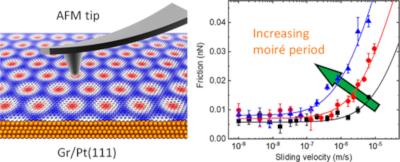Researchers from the University of Basel and Tel Aviv University have reported insights relating to friction in graphene. If graphene is applied to a platinum surface, it has a significant impact on the measurable friction forces. The team found that in this instance, the friction depends on the speed at which the tip of an atomic force microscope is moved across the surface.
This finding is surprising because friction does not depend on speed according to Coulomb's law, which applies in the macro world.
In conjunction with the platinum substrate, graphene no longer forms only the hexagonal honeycomb pattern of carbon atoms and instead forms superstructures known as Moiré superlattices. The surface is then no longer completely flat and exhibits a certain degree of roughness.
"If we move the AFM tip across this slightly corrugated surface at low speed, we measure a weak and almost constant frictional force," explains Professor Ernst Meyer from the Swiss Nanoscience Institute and the Department of Physics at Basel University.
"Above a certain threshold, however, the friction then increases with the speed of the AFM tip," adds first author Dr. Yiming Song. "The larger the Moiré superstructure, the lower the threshold at which the friction becomes speed-dependent."
The researchers found that there is greater resistance at the ridges of the Moiré superstructures during the movement of the tip. These ridges undergo elastic deformation due to the pushing tip before relaxing again when the pressure is sufficiently high. This effect results in greater frictional forces that increase with the speed of the tip. Simulations and an analytical model confirm the experimental findings obtained by this international team of researchers.
